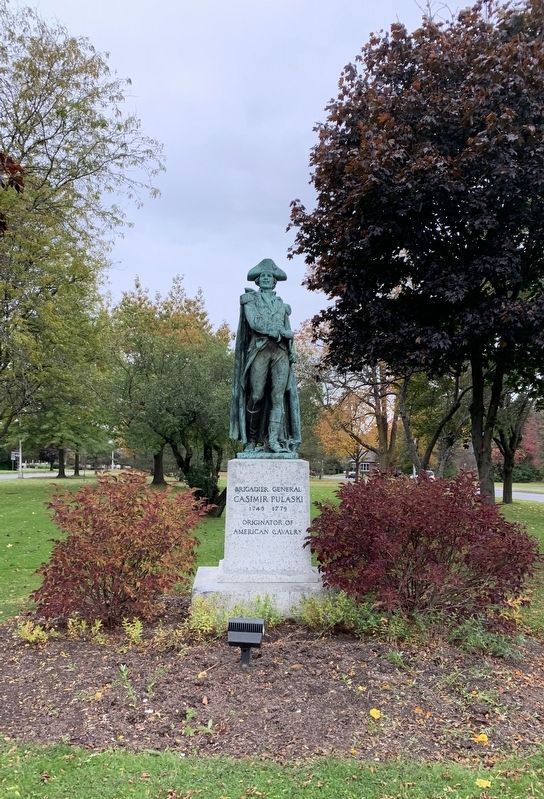Utica in Oneida County, New York — The American Northeast (Mid-Atlantic)
Casimir Pulaski
Brigadier General
Casimir Pulaski
1745- 1779
Originator of
American Cavalry
Topics. This historical marker is listed in this topic list: War, US Revolutionary. A significant historical year for this entry is 1779.
Location. 43° 5.198′ N, 75° 15.039′ W. Marker is in Utica, New York, in Oneida County. Marker is at the intersection of Memorial Parkway and Oneida Street, in the median on Memorial Parkway. Touch for map. Marker is in this post office area: Utica NY 13501, United States of America. Touch for directions.
Other nearby markers. At least 8 other markers are within 2 miles of this marker, measured as the crow flies. Oneida County Spanish-American War Memorial (within shouting distance of this marker); James Schoolcraft Sherman (approx. 0.3 miles away); Justus Henry Rathbone (approx. 0.6 miles away); Governor Horatio Seymour (approx. ¾ mile away); Utica Civil War Memorial (approx. 0.8 miles away); General Herkimer Marched Past This Spot (approx. 1.7 miles away); On August 5, 1777 (approx. 1.8 miles away); The Site of Old Fort Schuyler (approx. 1.8 miles away). Touch for a list and map of all markers in Utica.
Regarding Casimir Pulaski. Born on March 4th, 1745, in Warsaw, Casimir Pulaski grew up as a privileged aristocrat, but ended up fighting for liberty in Poland and America. With a rare combination of courage and military skills, made a significant impact on the course of the Revolutionary War.
He arrived in America in to participate in the Battle of the Brandywine. As the British forced the Americans off the field on the 11th of September, Washington realized, to his horror, that the right flank of his army was about to collapse, potentially causing a general rout and destroying his army. Pulaski volunteered to countercharge the British and give the Continentals time to withdraw in good order. With no time to argue, Washington entrusted Pulaski with his own mounted guard, about thirty in number, and watched as the Polish volunteer led his band directly into the fray, delaying the British long enough for the Continentals to retreat and possibly saving Washington’s life.
Pulaski spent most of his generalship leading small bands of horsemen on scouting patrols are raiding parties, as the Continental Army did not generally have a cavalry arm to speak of when he arrived. To him though, such a situation was unacceptable, and began working to rectify the issue. In the early spring of 1778, he offered to raise an independent cavalry unit for the army and was allowed to do so with little supervision or collaboration with his American counterparts, mostly because they hated working with him and dealing with his vain, arrogant demeanor.
In 1779, Washington sent Pulaski south to Charleston to support General Benjamin Lincoln in his march to recover Savannah, Georgia from British occupation. On the last day of the Siege of Savannah, Pulaski attempted to rally a group of fleeing Frenchmen by charging a British position, but was sadly struck by grapeshot and died some days later. He was buried with full honors at an unknown location, and his Legion was incorporated into the rest of the Continental Army.
Also see . . . Casimir Pulaski. (Submitted on October 22, 2019, by Steve Stoessel of Niskayuna, New York.)
Credits. This page was last revised on October 24, 2019. It was originally submitted on October 22, 2019, by Steve Stoessel of Niskayuna, New York. This page has been viewed 185 times since then and 13 times this year. Photo 1. submitted on October 22, 2019, by Steve Stoessel of Niskayuna, New York. • Michael Herrick was the editor who published this page.
